Do you have a question about the Enraf Nonius Sonopuls 492 and is the answer not in the manual?
Detailed breakdown of the 4-series device, identifying numbered parts and their functions, including switches, connectors, and controls.
Instructions for inspecting the device upon arrival, placing it correctly, and connecting essential components like the mains supply.
Guidance on safely connecting the device to the mains power, including switch operations and LED indicators.
Defines the target users for the 4-series device, specifying professional users in physical therapy and rehabilitation.
Lists contraindications for electrotherapy, covering pacemakers, cancerous lesions, and specific body areas.
Enumerate contraindications for ultrasound therapy, including malignancy, fractures, and specific body regions.
Safety precautions for ultrasound therapy, addressing hemorrhagic diathesis, patient sensitivity, and hygiene.
Safety guidelines for electrotherapy, including TENS, pregnancy use, and skin reactions.
Steps to turn on the apparatus, including self-test and readiness for use.
Guide on how to adjust current amplitude using the central controller after selecting a channel.
How to adjust parameters and intensity using the central controller on the parameter screen.
Procedure for saving and retrieving personalized treatment settings as Favorites.
Guide to creating sequential protocols by adding steps, storing, and naming them.
Personalizing unit settings like language, LCD brightness, speaker volume, and energy saver.
Guidance on applying flexible rubber, vacuum, and self-adhesive electrodes for electrotherapy.
Description of 4-pole interferential currents, including Classical and Isoplanar vector techniques.
Explanation of manual and automatic dipole vector techniques for targeted stimulation.
Description of TENS waveforms, including asymmetrical and alternating asymmetrical variants.
Explanation of the premodulated waveform, its parameters, and application for muscle strengthening.
Details on Russian stimulation, its history, parameters, and use for muscle strengthening.
Explanation of high voltage waveform, its parameters, and use for nerve/muscle stimulation and pain relief.
Overview of Diadynamic currents (MF, DF, LP, CP, CPid) and their applications in pain reduction and circulation.
Explanation of Faradic currents for muscle stimulation, diagnostics, and strength/duration curves.
Recommended current waveforms for pain management applications.
Recommended current waveforms for muscle stimulation applications.
Specifications for electrotherapy channels, amplitude range, timer, and polarity.
Guidance for resolving common issues like patient circuit interruption, low battery, and full water reservoir.
Troubleshooting steps for device errors, applicator errors, supply issues, and operational restrictions.
Requirements for technical maintenance, including electrical safety checks, annual servicing, and authorized personnel.
Compliance with medical device directives, safety standards (IEC 60601), and applied part classifications.
Detailed breakdown of the 4-series device, identifying numbered parts and their functions, including switches, connectors, and controls.
Instructions for inspecting the device upon arrival, placing it correctly, and connecting essential components like the mains supply.
Guidance on safely connecting the device to the mains power, including switch operations and LED indicators.
Defines the target users for the 4-series device, specifying professional users in physical therapy and rehabilitation.
Lists contraindications for electrotherapy, covering pacemakers, cancerous lesions, and specific body areas.
Enumerate contraindications for ultrasound therapy, including malignancy, fractures, and specific body regions.
Safety precautions for ultrasound therapy, addressing hemorrhagic diathesis, patient sensitivity, and hygiene.
Safety guidelines for electrotherapy, including TENS, pregnancy use, and skin reactions.
Steps to turn on the apparatus, including self-test and readiness for use.
Guide on how to adjust current amplitude using the central controller after selecting a channel.
How to adjust parameters and intensity using the central controller on the parameter screen.
Procedure for saving and retrieving personalized treatment settings as Favorites.
Guide to creating sequential protocols by adding steps, storing, and naming them.
Personalizing unit settings like language, LCD brightness, speaker volume, and energy saver.
Guidance on applying flexible rubber, vacuum, and self-adhesive electrodes for electrotherapy.
Description of 4-pole interferential currents, including Classical and Isoplanar vector techniques.
Explanation of manual and automatic dipole vector techniques for targeted stimulation.
Description of TENS waveforms, including asymmetrical and alternating asymmetrical variants.
Explanation of the premodulated waveform, its parameters, and application for muscle strengthening.
Details on Russian stimulation, its history, parameters, and use for muscle strengthening.
Explanation of high voltage waveform, its parameters, and use for nerve/muscle stimulation and pain relief.
Overview of Diadynamic currents (MF, DF, LP, CP, CPid) and their applications in pain reduction and circulation.
Explanation of Faradic currents for muscle stimulation, diagnostics, and strength/duration curves.
Recommended current waveforms for pain management applications.
Recommended current waveforms for muscle stimulation applications.
Specifications for electrotherapy channels, amplitude range, timer, and polarity.
Guidance for resolving common issues like patient circuit interruption, low battery, and full water reservoir.
Troubleshooting steps for device errors, applicator errors, supply issues, and operational restrictions.
Requirements for technical maintenance, including electrical safety checks, annual servicing, and authorized personnel.
Compliance with medical device directives, safety standards (IEC 60601), and applied part classifications.
| Frequency | 1 MHz and 3 MHz |
|---|---|
| Number of Channels | 1 |
| Therapy Forms | Continuous and pulsed |
| Type | Ultrasound Therapy Device |
| Pulse Frequencies | 100 Hz |
| Duty Cycles | 5, 10, 20, 50% |
| Applicators | 5 cm² |
| Power supply | 100-240 V, 50/60 Hz |
| Treatment Time/Timer | 1 - 30 minutes |
| Dimensions | Approx. 300 x 200 x 100 mm |
| Display | LCD |
| Pulse Ratio | 1:4, 1:1 |
| Output Power/Intensity (max) | 2 W/cm² |
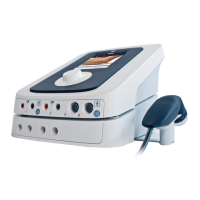
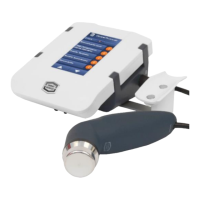
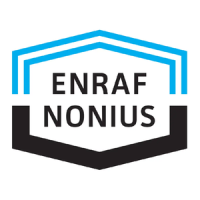

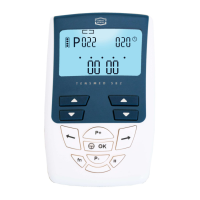

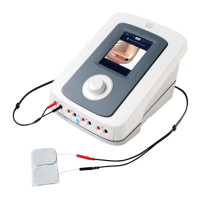

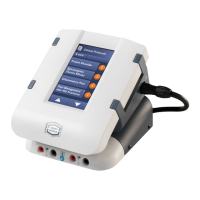
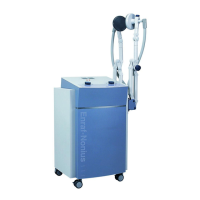

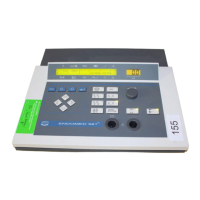
